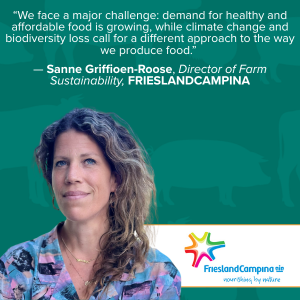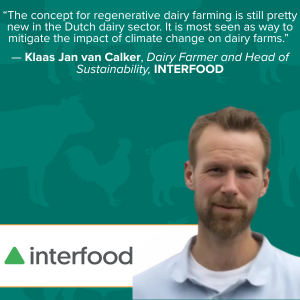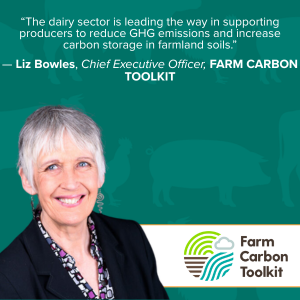Regenerative Dairy: Profitability and Resilience in a Changing Climate
Dairy farming in Europe is at a crossroads, with climate change, volatile input prices, and increasing sustainability demands reshaping the sector. For many in the industry, regenerative agriculture has emerged not just as an environmental imperative, but as a business strategy for long-term resilience and profitability.
Ahead of the Animal AgTech Innovation Summit in Amsterdam this October, industry leaders from the Netherlands and the UK reveal how regenerative agriculture is being interpreted, tested, and scaled in practice within the dairy industry.
Regenerative Ag: A Shift in Dairy Farming
 “Regenerative agriculture is about producing in balance with the planet, with measurable results on soil, water, biodiversity, and climate,” explains Sanne Griffioen-Roose, Director of Farm Sustainability at FrieslandCampina.
“Regenerative agriculture is about producing in balance with the planet, with measurable results on soil, water, biodiversity, and climate,” explains Sanne Griffioen-Roose, Director of Farm Sustainability at FrieslandCampina.
Liz Bowles, CEO at the Farm Carbon Toolkit, adds that the dairy industry is increasingly turning to regenerative practices in response to growing climate and nature-related pressures. However, while there’s no one-size-fits-all model, the transition is guided by shared principles: restoring soil health, reducing reliance on external inputs, and building resilience to climate extremes.
Adding another Dutch perspective, Klaas Jan van Calker, Dairy Farmer and Head of Sustainability at Interfood, notes that regenerative agriculture is still a relatively new concept in the industry, but one increasingly seen as a response to the climate crisis. “We all see more droughts and heavy rains. For farmers, regenerative agriculture can mean a more secure and resilient farm model.”
In the Netherlands, FrieslandCampina is testing a structured pathway with nearly 60 farmers across three phases: Embark, Enhance, Evolve. “Each farm is unique, so this allows farmers to test practical and financial feasibility while sharing knowledge as a community,” says Griffioen.
In the UK, Bowles points to a transition towards more forage-based systems with less fertiliser and purchased feed, supported by diverse awards and longer grazing. “The dairy sector is leading the way in supporting producers to reduce GHG emissions and increase carbon storage in farmland soils,” she adds.
Despite different starting points, all three experts see regenerative dairy as a move towards systems that are more nature-inclusive, less dependent on costly inputs, and better positioned for future shocks.
Profitability and Resilience
The question many farmers ask first is economic: how do regenerative systems stack up against conventional high-input models?
Bowles argues that resilience is their greatest strength: “Exposure to risk from volatile input prices is reduced, and enhanced soil health improves flood and drought tolerance. Financial results can be similar to conventional systems, but outcomes depend heavily on the relationship between milk price, feed price, and fertiliser costs.”
Griffioen shares a similar view, noting that profitability is still being tested through FrieslandCampina’s study groups: “Regenerative farming requires upfront investment and a long-term perspective, while farmers operate in highly volatile markets. That is why we collect both environmental and financial data to help farmers decide which practices are viable.”
Van Calker adds that, “while consolidation and intensification still have appeal, regenerative elements are gaining traction as part of a risk management strategy.” In fact, some practices – such as permanent grassland, grazing of dairy cows, crop rotation, and cover crops – are already being rewarded by the market, banks or the government.
Policy and Support Mechanisms
Policy frameworks play a crucial role in helping farmers manage the risks of transitioning to regenerative systems.
In the Netherlands, FrieslandCampina has embedded incentives into its cooperative model. “Since 2018, we have measured sustainability performance on all member farms. Our farmers received a total of €228 million for their sustainability achievements in 2024,” says Griffioen. National programmes like ReGeNL also provide funding and standards for regenerative adoption.
Van Calker, however, highlights a key gap in subsidies. Since “the single farm payment is still very focused on practices instead of impact,” a shift to impact-based rewards would accelerate the transition towards more regen and agroecological practices.
In the UK, public support is more fragmented, Bowles explains: “England’s Environmental Land Management Scheme has been supporting producers to adopt more sustainable farming systems, but it is currently paused. In Wales and Scotland, funding is tied to producing farm carbon footprints, which then unlocks access to other environmental funding schemes.” However, many dairy supply chains are developing mechanisms to support dairy farm transition.
Yet, the message from all three is clear: consistent, long-term policy signals are vital to give farmers the confidence to invest in regenerative systems.
Technology and Knowledge Sharing
Technology is seen as a key enabler, but not a substitute for farmer knowledge and trust. And, in fact, all three experts underline that data ownership must remain with the farmer.
“Technology will be essential to make regenerative practices both scalable and measurable,” says Griffioen, pointing to soil monitoring, precision grazing, and herd health systems. Yet she cautions that affordability and accessibility remain barriers, requiring collective approaches and fair data governance.
Bowles echoes the importance of human support alongside digital tools: “Simply providing a number does little to effect change without advice from someone who understands the challenges farmers face. Peer to peer learning works well, especially when backed by on-farm trials as ‘seeing is believing’.” Van Calken agrees, adding that the challenge is turning raw data into actionable insights. The fact is that technologies are only valuable if they support farmers’ decision-making.
Supply Chain and Shared Risk Models
The transition to regenerative dairy cannot rest on farmers’ shoulders alone. Both experts emphasise the need for shared responsibility across the supply chain.
In the Netherlands, FrieslandCampina is testing new partnerships. “A successful transition requires models that fairly distribute risks and rewards,” says Griffioen. In fact, their recent collaboration with Lidl on a three-year regenerative study group shows how today’s challenges can turn into tomorrow’s opportunities.
Van Calker points to the role of impact-based value. “Giving value to improvements in climate, water quality, biodiversity and animal welfare is key,” he adds. That’s how risk and reward can be more fairly distributed.
 In the UK, Bowles highlights similar efforts by cooperatives to reward producers for restoring nature and reducing emissions. But she warns of challenges in the voluntary carbon market: “For dairy farmers producing milk from long-term permanent pastures, the headroom to remove more carbon is limited. Incentives need to also reward maintaining these already high levels of soil carbon.”
In the UK, Bowles highlights similar efforts by cooperatives to reward producers for restoring nature and reducing emissions. But she warns of challenges in the voluntary carbon market: “For dairy farmers producing milk from long-term permanent pastures, the headroom to remove more carbon is limited. Incentives need to also reward maintaining these already high levels of soil carbon.”
Scaling Through Collaboration
Ultimately, acceleration will require action from every part of the value chain – from farmers and corporates to innovators, and consumers.
“Consumers must reward sustainable choices, corporates need to integrate regenerative criteria into sourcing, and innovators must provide new tools and business models,” argues Griffioen. FrieslandCampina’s vision is to have 1,000 member farms in its regenerative programme by 2030, backed by a transparent and measurable international standard.
Bowles points to the role of consumer trust and animal genetics. “Where demand recognises the benefits of regenerative farming for the planet, animals, and human health, there is a greater appetite to pay.” And, anticipating a shift in cattle genetics and system design, she believes that by 2030, we’ll recognise the need for dairy cows with longer herd lives, better able to thrive in forage-based systems, driving resilience and reducing emissions.
Van Calker sees retailers, brands, and governments as the main drivers. “Consumers will play a smaller role. It’s the institutions that must align on the same ‘true value’ language and push farmers in the right direction.” For him, evidence of impact will be the ultimate decisive factor.
Conclusion
Regenerative dairy is no longer an abstract idea; it is being tested, implemented, and scaled by farmers across Europe. While the UK and Dutch contexts differ, both show that regenerative practices can deliver economic resilience, environmental benefits, and stronger supply chains.
The message is clear: regenerative dairy is both an opportunity and an imperative. But its success will depend on collaboration across farmers, processors, retailers, policymakers, and consumers to create systems that are profitable, resilient, and fit for the future.
As Griffioen puts it, “the ultimate goal is to create value for farmers, nature, and society while continuing to provide high-quality, affordable dairy for a growing world population.” Similarly, Bowles adds a reminder of what’s at stake: regenerative dairy is not only about adaptation, but about building a just and resilient future for farmers and the food systems.
Regenerative dairy will take centre stage at the Animal AgTech Innovation Summit in Amsterdam on October 16-17, as the industry explores more resilient, sustainable models. Join Liz Bowles, Sanne Griffioen-Roose, and Klaas Jan Van Calker as they share more on the topic live on stage during the panel ‘Regenerative Dairy: Profitability & Resilience in a Changing Climate.’
)
)
)
)
)